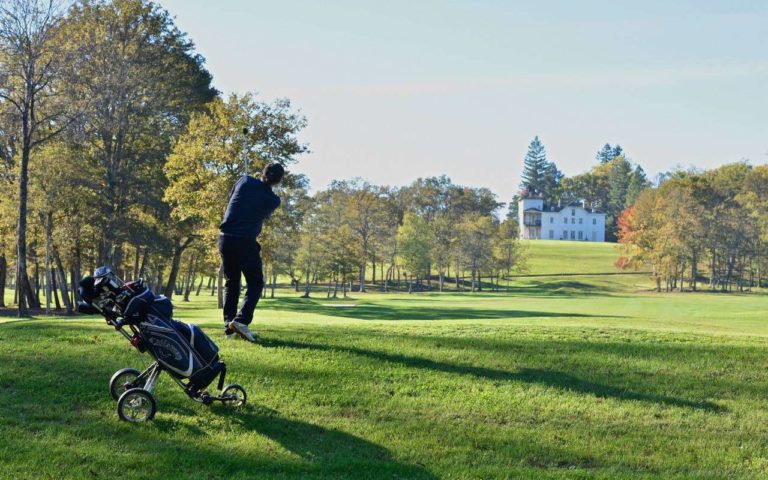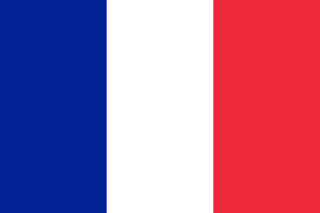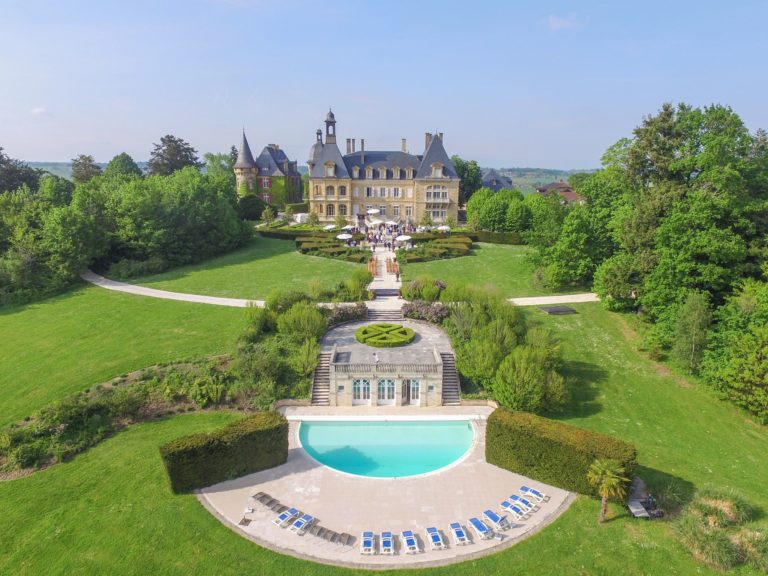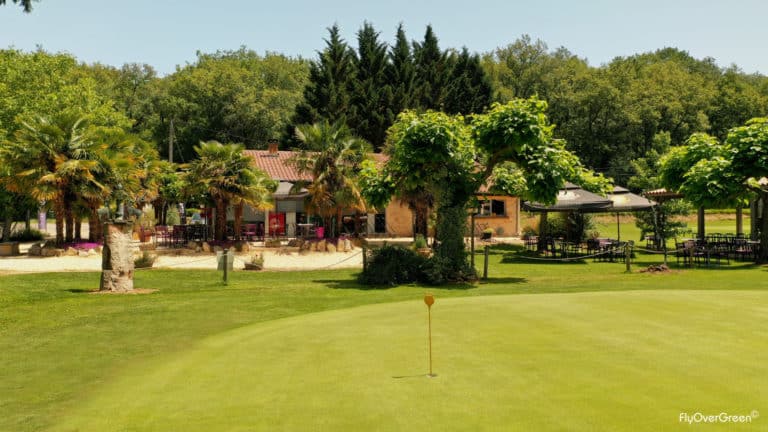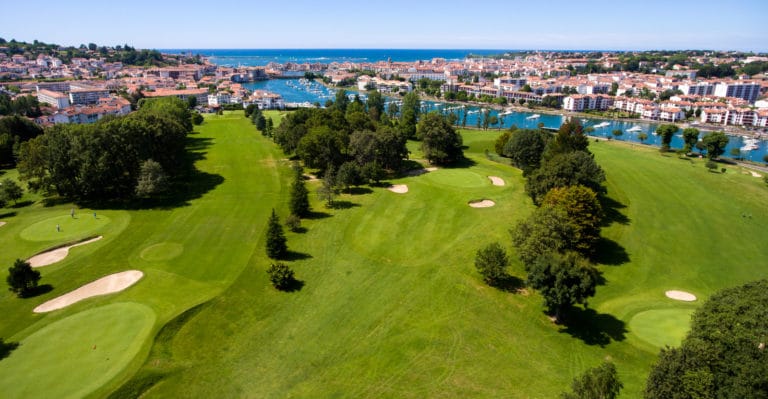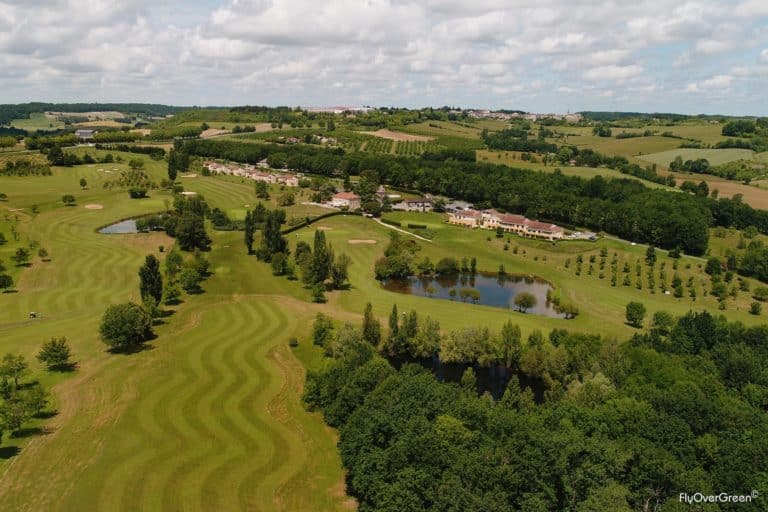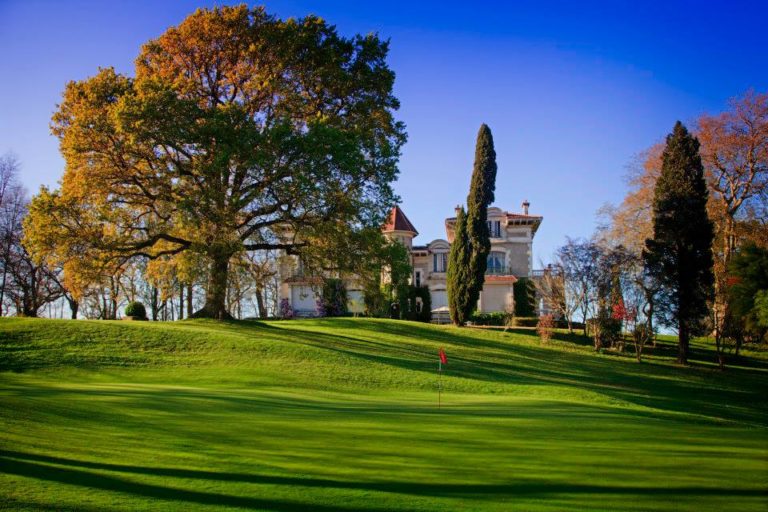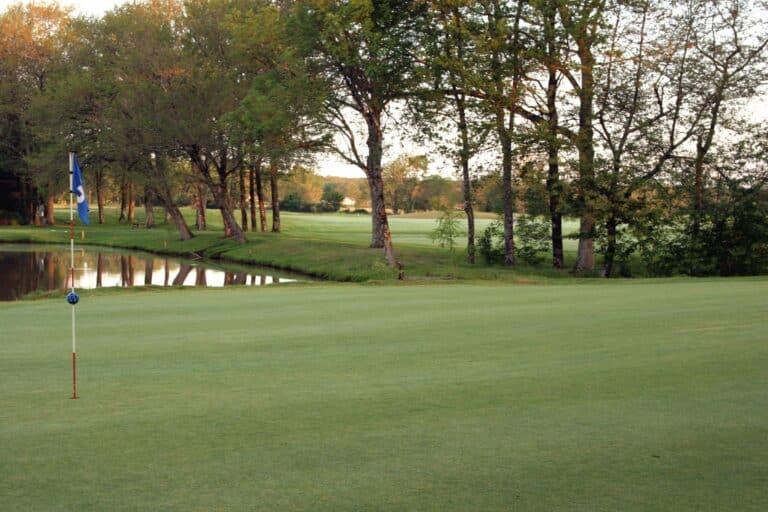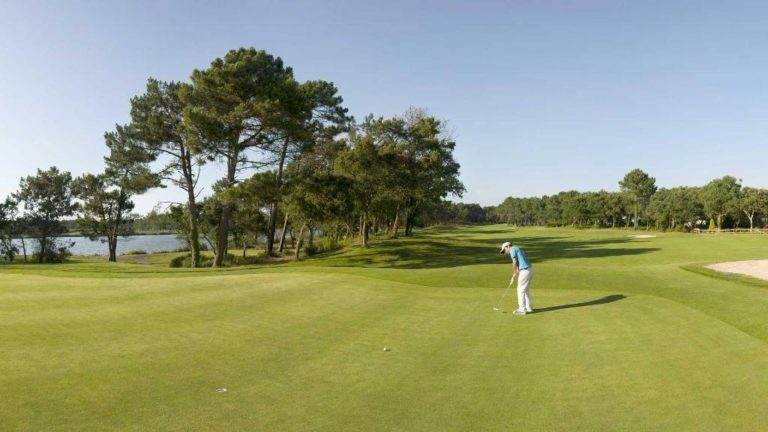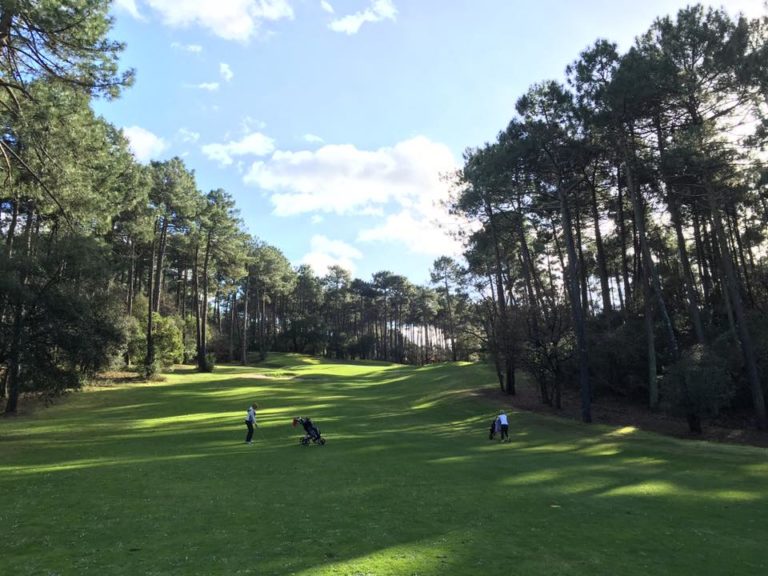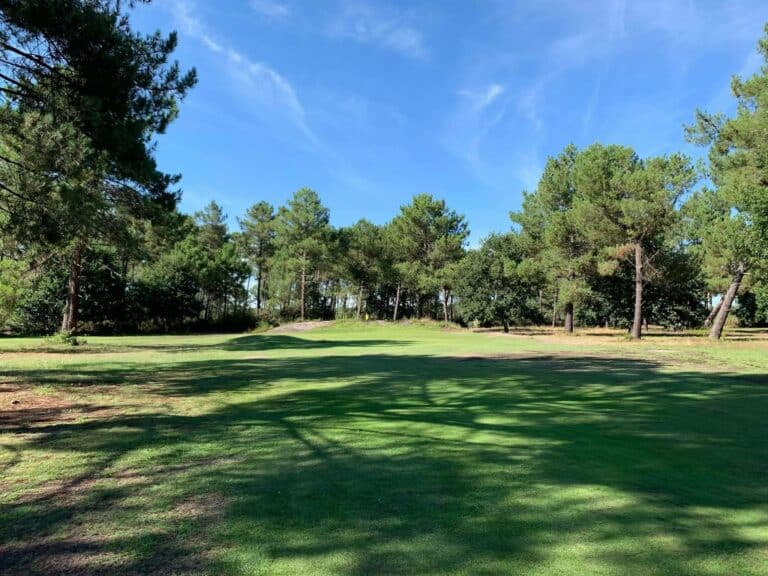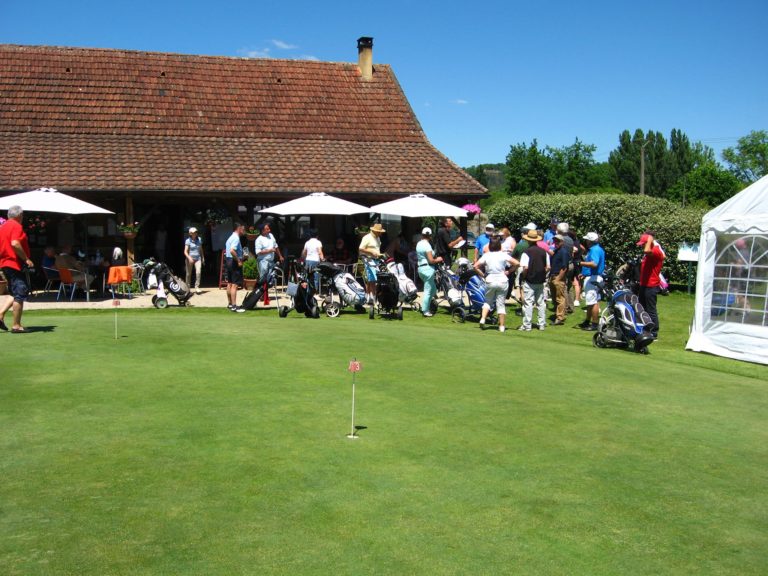Golf courses in New Aquitaine
Discover the detailed guide to all the golf courses located in the Nouvelle-Aquitaine region. You can leave a comment, a vote or an anecdote on all the golf courses in the golf directory
Where to play golf in New Aquitaine? The detailed guide to all the golf courses in the region
-
Located in Béarn, in the town of SUS in the Pyrénées Atlantiques department, in the immediate vicinity of the town of Navarrenx famous for its ramparts, its cigars and its magnificent city center, the Golf de Navarrenx is an 18-hole course, par 72, 6400 meters long.
Designed by Nicolas Joakimides, professional PGA player, this hilly course presents always different playing situations giving all its character to this golf course. Fun, technical but accessible to all, at all levels, you will find on this course something to have a very pleasant time, whatever your index.
The idyllic setting of this new 140-hectare golf course, from its hundred-year-old trees to its castle, offers you both action and serenity, a sports course or a walk, as you wish, accompanied on your way by a unique view. on the Pyrenees mountains.
The Navarrenx Golf Club course is strategic and entertaining, suitable for both novices and experienced golfers. Its exceptional geographical location makes it an essential and accessible place for golf enthusiasts, in the heart of Béarn des Gaves, between the Basque Country and the Spanish border, halfway between Pau airport and Biarritz airport.
Come and recharge your batteries for a weekend, taste the pleasures of unspoiled nature, and indulge in the joys of your favorite sport.
- Architect: Nicolas JOAKIMIDES
- France, Nouvelle-Aquitaine, Pyrénées-Atlantiques - Golf holidays book a hotel near the Navarrenx Golf Club - Best price reservation
- 18 holes 6400 meters
- Service: Snack bar, Manual trolley, Teachers, Golf cart, Approach green, Small game area, Club rental, Compact course, Practice, Proshop, Putting green, Restaurant, Conference rooms Seminar, Locker rooms, Wi-Fi Club House internet connection
-
In the heart of the Périgord vert, the golf course and Domaine d'Essendiéras welcomes you on more than 360 hectares of beautiful French countryside.
An exceptional place, steeped in history, it was owned by great personalities such as academician André Maurois and businessman Sylvain Floirat. Let yourself be surprised by its two XNUMXth and XNUMXth century castles, its exceptional views and perspectives.The 9-hole par 36 course of 2849 meters offers spectacular views of the Perigord countryside. It offers real challenges for golfers of all levels. Practice, putting green, pitching green, golf carts ... Everything is there for the happiness of the golfer. The golf course is open all year round.
- Architect: Willem SWART
- France, Nouvelle-Aquitaine, Dordogne - Golf holidays book a hotel near the Golf du Domaine d'Essendieras - Best price reservation
- ESSENDIÉRAS 9 holes 2849 meters
- Service: Snacking bar, Electric trolley, Manual trolley, Teachers, Golf cart, Approach green, Small game area, Club rental, Compact course, Swimming pool, Practice, Proshop, Putting green, Restaurant, Conference rooms Seminar, Accommodation and hotels near the golf course for stays and weekends, Changing rooms, Wi-Fi Club House internet connection
-
The Lolivarie golf course is located in Saint-Germain-de-Belvès, a pretty French town located in the Dordogne department, in the Nouvelle-Aquitaine region. Its 18-hole course deploys its greens and fairways along a very small stream, in the middle of large oaks, poplars and willows over approximately 6 meters in the heart of the Périgord Noir, between castles and picturesque sites. .
Golf historyA friendly welcome is required in this golf course, the first 9-hole course of which dates back to 1984. It was the work of Jean Duc, then owner of a hotel-restaurant on the site and who wanted to offer his customers - canoeing , walks and Golf.
The first nine completely flat holes then emerge from the farmland located below Lolivarie, a small medieval Périgord village which gave its name to the golf course.
In the early 2000s, Simone and André AZOULAY bought the golf course and the purchase of new plots allowed the course to go from 9 to 18 holes in 2001.The course
The aerial view of the Lolivarie golf course is surprising. Indeed, it shows an almost symmetry of the two 9 holes, a bit like a butterfly with outstretched wings with the Club-House between the outward journey and the return. Over time, the routes have become more firmly established and the two parts of the route present very distinct challenges.
The first 9 holes
The going is to be attacked with humility and modesty. Indeed, the greens are delicate and we quickly find ourselves in the small stream which borders almost all of the first 9 holes.
The last 9 holes
On the way back, you will have to take out the driver to investigate a few bridles. With three par 5s including the 14th, the longest par 5 in the department with 536m of white benchmarks, the nine new holes are inspired by American courses with space at the end of the drive but obstacles to overcome.
The signature hole
Number 12, the signature hole of the Lolivarie golf course, is a par 4 of 297 meters welcoming two ponds and equipped with a relatively short peninsula green, it symbolizes this Florida fragrance distilled in the Dordogne valley.In the end, you will walk a technical course suitable for all levels of play.
You will find an ideal structure for training and golf courses thanks to the two approach holes, the putting green and the imposing driving range. Also, competitions and tournaments are organized throughout the year. Finally, the clubhouse and the brasserie where you will receive a warm welcome will win you over.
- Architect: Jean Louis PEGA
- France, Nouvelle-Aquitaine, Dordogne - Golf holidays book a hotel near the Golf de Lolivarie - Best price reservation
- LOLIVARIE 18 holes 5896 meters
- Service: Snack bar, Manual trolley, Teachers, Golf cart, Approach green, Small game area, Club rental, Practice, Proshop, Putting green, Restaurant, Conference rooms Seminar, Locker rooms
-
Created in 1907, the tree-lined Nivelle golf course winds around a hill between ocean, river and mountain. it was originally designed by renowned champion and architect JHTaylor.
It is a unique typically British route, very varied and hilly, allowing you to discover in turn superb panoramas: the ocean, the Nivelle, the port of Saint Jean-de-Luz and the Pyrenees.
This 18-hole Par 70 course of 5685 meters is technical: the relief and the slope, sometimes steep, require the golfer to adapt throughout the course his position, his stance and his swing; the steep and fast greens are demanding.
The Nivelle golf course is appreciated for the quality of its terrain. It will suit beginners as well as experienced golfers. - Architect: JH. TAYLOR
- France, Nouvelle-Aquitaine, Pyrénées-Atlantiques - Golf holidays book a hotel near the Golf de la Nivelle - Best price reservation
- LA NIVELLE 18 Holes 5685 meters
- Service: Snack bar, Manual trolley, Teachers, Golf cart, Approach green, Small game area, Club rental, Compact course, Practice, Proshop, Putting green, Restaurant, Conference rooms Seminar, Locker rooms
-
Close to La Rochelle, the Golf de la Prée is the only 18-hole golf course in Charente Maritime Nord. Superb course, it will require golfers to handle the ball well in order to tame it. Indeed, its many obstacles (bunkers and water obstacles) and its almost wind can make it formidable. It is a must for all golf lovers.
The 18-hole golf course of La Prée La Rochelle harmoniously combines the characteristics of a seaside Links and those of a plain golf course, with a few shrubs, lakes and streams. To fully appreciate it, you have to enjoy playing under the caress of the sea breeze and mastering a wide variety of strokes (Low ball, "Stinger", "Fade", "Draw"). The magnificent view of the ocean is there, to charm you!
The lakes and streams populated by ducks and coots remind us that this ancient swamp is also the land of choice for many species of birds. Facing the Ile de Ré and the Baie de l'Aiguillon, this iodized course has all the qualities of a real Scottish links ...
From the club house, the view is breathtaking. The restaurant, with large bay windows, allows you to appreciate the evolutions of the players while tasting the dishes concocted by the chef. The bar and its lounge with a cozy atmosphere will welcome your moments of relaxation.
- Architect: Olivier BRIZON
- France, Nouvelle-Aquitaine, Charente-Maritime - Golf holidays book a hotel near the Golf de La Prée La Rochelle - Book best price
- LA PRÉE LA ROCHELLE 18 holes 5956 meters
- Service: Snacking bar, Manual trolley, Teachers, Golf cart, Approach green, Small game area, Club rental, Compact course, Practice, Proshop, Putting green, Restaurant, Conference rooms Seminar, Accommodation and hotels near the golf course for stays and weekends, Changing rooms, Wi-Fi Club House internet connection
-
The Golf de Villeneuve sur Lot is located in Castelnaud-de-Gratecambe, a pretty town in the great southwest of France, in the Lot-et-Garonne department, in the Nouvelle-Aquitaine region.
The 18-hole course
The golf course of Villeneuve sur Lot deploys its greens and fairways over 6109 meters to offer a magnificent 18-hole course which marries a hilly landscape and brightly decorated with plum trees and orchards. It is recognized as one of the best golf courses in Aquitaine. .Between sumptuous bodies of water, uneven fairways, high greens and others below, the Golf de Villeneuve sur Lot will surprise and enchant you on each of its holes.
Training zones
To complete its offer, the Villeneuve sur Lot golf course has many training areas:Practice, covered posts, outdoor posts
2 putting greens
Training bunkers
Green approaches
Pitching greens - Architect: Robert BERTHET
- France, Nouvelle-Aquitaine, Lot-et-Garonne - Golf holidays book a hotel near the Golf de Villeneuve sur Lot - Best price reservation
- VILLENEUVE SUR LOT 18 holes 6109 meters
- Service: Snack bar, Manual trolley, Teachers, Golf cart, Approach green, Small game area, Accommodation and hotels near the golf course for stays and weekends, Club rental, Compact course, Driving range, Proshop, Putting green, Restaurant, Conference rooms Seminar, Changing rooms, Wi-Fi Club House internet connection
-
Ideally located between Fontevraud-l'Abbaye, Loudun, Saumur and Chinon, the Golf de Loudun-Fontevraud deploys its greens and fairways in the heart of the 120 hectares of the Domaine de Roiffé.
Created in 1985 by the French architect Hubert Chesneau, this 18-hole golf course offers a straightforward and varied course over more than 60 hectares, partly wooded and hilly.Relatively long (6181 meters), it has some nice surprises in store such as a dominant headwind, a steep slope or a deep stony ditch. Its renovation in 2015 makes it a particularly pleasant route that winds between the Fontevraud forest, the estate's pond and the XNUMXth century Tuffeau stone mansions.
Also, the various infrastructures dedicated to golf, allow you to vary the pleasures according to your level, your objectives and the time you have:
18 golf holes
Compact 6-hole course,
putting green,
Green approaches
40 practice stations including ten covered
Training bunker - Architect: Hubert CHESNEAU
- France, Nouvelle-Aquitaine, Vienne - Golf holidays book a hotel near the Loudun-Fontevraud golf course - Best price reservation
- LOUDUN 18 holes 6181 meters
- Service: Snacking bar, Electric trolley, Manual trolley, Teachers, Golf cart, Approach green, Small game area, Club rental, Compact course, Swimming pool, Practice, Proshop, Putting green, Restaurant, Conference rooms Seminar, Accommodation and hotels near the golf course for stays and weekends, Changing rooms, Wi-Fi Club House internet connection
-
On September 24, 2016, the 18-hole Bressuire golf course and the clubhouse were inaugurated in the presence of numerous personalities. The opinions are unanimous: superb and varied course, very high quality Club-House with an exceptional view on the Bocage and on the city.
The great course18 holes - Par 72 - 6005 meters
A flagship municipal project, the 18-hole course is developing north of the city, a true green lung of a future village of 400 homes. Less than a kilometer from the historic city center, it offers a play area with natural landscapes. Built from 2014 to 2016 by the architect Yves Bureau, the 18-hole Grand Puchaud offers golfers a technical and physical course in the heart of the bocage Bressuirais between the granite valleys and the Dolo.
The Compact Course / Pitch and Putt
This course designed collectively between Jean-Michel Bernier, Mayor of Bressuire and Claude Sageot-Chomel, President of the GCBB from 2011 to 2014, was carried out by a team of volunteers, members of the club and with the support of municipal services.Choose yours! The course offers two possibilities of play, both compact (distances between 50 and 140 m) and both Pitch and Putt (distances between 50 and 90 m). Allowing beginners to discover golf quickly and seasoned golfers training in effective approaches, this pretty course has everything to seduce you.
Training areas
With a 3 1/2 hectare practice area with 6 covered seats, 25 outdoor seats, a wedging zone, a pitching green and a putting green, this pleasant training area offers all players the pleasure of working on their swing.
Course maintenance: Towards ecological management
The courses have been maintained with ecological products since 2013 (organic fungicides based on minerals and trace elements). Mechanical operations promoting aeration of the greens are carried out regularly. Watering is also controlled by a restricted use of water (use of rainwater, water reserves, watering only of the greens and tees) over 2 ha. The materials used are hybrids, a way of getting as close as possible to the nature that surrounds us. - Architect: Yves BUREAU
- France, Nouvelle-Aquitaine, Deux-Sèvres - Golf holidays book a hotel near the Golf de Bressuire - Best price reservation
- LARGE COURSE 18 holes 6005 meters
- Service: Snack bar, Manual trolley, Teachers, Golf cart, Approach green, Small game area, Club rental, Compact course, Practice, Proshop, Putting green, Restaurant, Conference rooms Seminar, Locker rooms, Wi-Fi Club House internet connection
-
Arcangues golf course is located in the town of the same name in the Pyrénées-Atlantiques department in the Nouvelle-Aquitaine region. Bordering two municipalities which enjoy an opening on the Atlantic Ocean, Biarritz and Anglet, it deploys its greens and fairways in hilly terrain
Whether staying in the Basque Country or native of the region, come and discover this 18-hole course and its breathtaking view of the Pyrenees. Between mountain and ocean, this peaceful course is distinguished by its many natural drops.
A family story
The Golf d'Arcangues was created in the 90s by the brothers Guy and Jean d'Arcangues. Designed by the American architect Ronald Fream, it is part of the second generation of the Basque Coast courses. Family property since 1150, the brothers Guy and Jean d'Arcangues decided to transform farmland into a golf course. The result is that of a hilly course, very fun and fair.Favorite place for professional golfers, a small game center was created in 2011. We regularly see players such as Grégory Bourdy, Romain Wattel, Edouard Espana and Benjamin Hébert under the rigorous eye of their trainer.
The Golf d'Arcangues is today a homogeneous site around a preserved environment where a warm and friendly atmosphere reigns.
A superb 18-hole course in the heart of the Basque Country
Located in the heart of the Basque Country, with its unobstructed view of the Pyrenees, the Arcangues Golf course knows how to seduce golfers of all levels. After reveling in the peaceful views of the Basque countryside on the way out, you will enjoy three holes on your return encircling the Castle of Arcangues, before walking along the famous cemetery housing the tomb of Luis Mariano. The efforts made to reach the green of 16 will be rewarded with a panorama of the Rhune massif and the Atlantic Ocean. - Architect: Ronald FREAM
- France, Nouvelle-Aquitaine, Pyrénées-Atlantiques - Golf holidays book a hotel near the Golf d'Arcangues - Best price reservation
- ARCANGUES 18 holes 5758 meters
- Service: Snack bar, Manual trolley, Teachers, Golf cart, Approach green, Small game area, Club rental, Compact course, Practice, Proshop, Putting green, Restaurant, Conference rooms Seminar, Locker rooms, Wi-Fi Club House internet connection
-
Located in the town of Les Forges in Deux Sèvres, the Domaine des Forges golf course takes its name from the charming XNUMXth century castle.
On some 110 hectares there are 3 9-hole "Blue", "White" and "Red" courses, which can be mixed into 18-hole courses.Par 36 of 3 m
Par 37 of 3 m
Par 36 of 3 mWhether you are a beginner or experienced, we like to evolve on these different circuits, some wooded, others flat, each one combining the pleasure of the game and varying difficulties (reinforced bunkers, beautiful bodies of water, subtle drops sometimes making the greens unpredictable. ).
The Domaine des Forges golf course is undoubtedly one of the most beautiful golf resorts in the Poitou-Charentes region.In addition for training, the golf course is equipped with:
A practice area 20 stations including 5 covered
A Putting green
A training bunker - Architect: Bjorn ERIKSSON
- France, Nouvelle-Aquitaine, Deux-Sèvres - Golf holidays book a hotel near the Golf du Château des Forges - Best price reservation
- BLUE-WHITE 18 Holes 5946 meters
- Service: Snack bar, Manual trolley, Teachers, Golf cart, Approach green, Small game area, Club rental, Swimming pool, Practice, Proshop, Putting green, Restaurant, Conference rooms Seminar, Accommodation and hotels near the golf course for stay and weekends, Changing rooms, Wi-Fi Club House internet connection
-
The Golf de Pinsolle is located on the Landes coast, in an idyllic setting, where only nature expresses itself.
Nestled between pines and ocean, the structure welcomes you by offering you a course made up of 9 holes which will delight both beginners and experienced, with its diversity and technicality.
On the other hand, the site has an exceptional training area since it contains no less than 3 putting greens, including one with possible bunker exit and 30 water practice stations, 6 of which are covered.
All the conditions and infrastructures are there to perfect your golf.
Training areasJust a few steps from the Club House you will find several training areas for big and small games with a magnificent view of the lake.
The Practice
It is a practice on water with about thirty mats, 9 of which are covered.
Open to everyone, every day
2 tokens 5 €
6 tokens € 10.Small game area
Also, two Putting-greens and an approach zone will allow beginners as well as experienced ones to take advantage of this ideal setting to train and polish their little game.
- Architect: Pierre THEVENIN
- France, Nouvelle-Aquitaine, Landes - Golf holidays book a hotel near the Golf de Pinsolle - Best price reservation
- PINSOLLE 9 holes 5056 meters
- Service: Snack bar, Manual trolley, Teachers, Golf cart, Approach green, Small game area, Club rental, Practice, Proshop, Putting green, Restaurant, Conference rooms Seminar, Locker rooms
-
La Méjanne golf course is a 9-hole, par 36 course of 3209 meters. It is distinguished by the technicality of its layout and its privileged location. Designed by Jean Garaialde, this course has been designed as a real championship course. Indeed it has all the technical and tactical characteristics:
It is characterized by its length, vast technical greens, lakes, numerous strategically placed bunkers, and undergrowth of pines, oaks and strawberry trees.
In the heart of a majestic forest, the course enjoys rare tranquility, just 3 kilometers from the ocean. - Architect: Jean GARAIALDE
- France, Nouvelle-Aquitaine, Gironde - Golf holidays book a hotel near the Golf de La Méjanne - Best price reservation
- MÉJANNE 9 holes 3210 meters
- Service: Snack bar, Manual trolley, Teachers, Golf cart, Approach green, Small game area, Club rental, Practice, Proshop, Putting green, Restaurant, Conference rooms Seminar, Locker rooms
-
The Château des Vigiers Dordogne golf course is located near the Périgord Noir, very close to Bergerac and Saint-Emilion. In an exceptional setting, you will be able to discover a unique golf variety in Aquitaine with 3 world-class 9-hole courses. Experienced golfer or beginner, it is an ideal place to discover new golfing sensations in a friendly atmosphere.
3 courses suitable for all levels
The three perfectly maintained courses were designed by Donald Steel who is considered one of the best "natural" golf architects. Thus, he was able to create in a unique environment, three fascinating paths in the middle of plum trees, oak woods, the lake and vineyards.
The Valley course9 holes | 3112m | By 36 | Architect: Donald Steel (2006)
A real golfing challenge: The valley is a demanding course. The holes are long but open. The greens are fast and endowed with lines that are sometimes difficult to read.
The Lake course9 holes | 2937m | By 35 | Architect: Donald Steel (1991)
A magnificent course: The course of the lake is of exceptional beauty. Its last hole is spectacular with a bird's eye view of the 4th century castle. It is equipped with PAR XNUMX techniques and difficult to achieve.
The Vines Route9 holes | 3083m | By 36 | Architect: Donald Steel (1991)
A course in the middle of the vines .: This course was designed around vines and plum trees. It appears to be easy to play but the results prove that it is difficult to score.
A complete practice
The golf des Vigiers offers structures adapted to teaching and discovering golf to guarantee you the best progress. The different spaces meet the needs of simple and effective teaching.A driving range covered with 6 mats,
Two training zones on grass
Two approach greens of 300 m² in area
A putting green
A chipping green
Two training bunkers
A 6-hole training course
A course approved for “Pitch & Putt” competition
Two "par 4" of (229 and 244 meters)
Four "par 3" of (100 to 181 meters) - Architect: Donald STEEL
- France, Nouvelle-Aquitaine, Dordogne - Golf holidays book a hotel near the Golf du Château des Vigiers - Best price reservation
- THE VINES - LE LAC 18 holes 6020 meters
- Service: Snacking bar, Electric trolley, Manual trolley, Teachers, Child care, Golf cart, Approach green, Small game area, Accommodation and hotels near the golf course for stays and weekends, Club rental, Mini golf, Compact course, Swimming pool, Practice, Proshop, Putting green, Restaurant, Conference rooms Seminar, Changing rooms, Wi-Fi Club House internet connection
-
On the edge of the Arcachon Basin, the Golf des Aiguilles Vertes deploys its greens and fairways in the town of Lanton in the southwest of France, in the department of Gironde.
The Golf des Aiguilles Vertes has a charming 9-hole golf course. This golf course built on the sand preserves the quality of the fairways and greens all year round. The name of the golf course: "Les Aiguilles Vertes" sets the tone and the pines accompany you throughout the course. Fairly flat and evolving in the pine forest, it is accessible to all, playable all year round and every day.
The welcome is warm, and the salty air whets the appetite: the Arcachon Bay and its oyster huts are close by and you will have the pleasure of commenting on your round of golf around a plate of oysters.
- Architect: Olivier BRIZON
- France, Nouvelle-Aquitaine, Gironde - Golf holidays book a hotel near the Golf des Aiguilles Vertes - Best price reservation
- GREEN NEEDLES 9 Holes 2250 meters
- Service: Snacking bar, Manual trolley, Teachers, Approach green, Small game area, Club rental, Proshop, Putting green, Restaurant, Changing rooms
-
The golf course of the Forge takes its name from the old forge of the agricultural domain of yesteryear, whose walls now house the golf workshop, while the old tobacco dryer houses the club house ...
Located in Siorac-en-Périgord in Dordogne (24) region with a thousand treasures of nature, culture and tradition. The Golf de la Forge is a beautiful and complete 9-hole course.
Always master of the place, the Gibert family favors a relaxed and attentive welcome. In addition, he maintains love and care on his journey. This pretty 9-hole course is suitable for beginners as well as experienced golfers.
The course includes raised departures, woods, wild flowers, bunkers, streams and body of water which adorn this par 30 long of 1411 meters.
In addition to the scattered bunkers and water features, the streams crossing the area are an integral part of the obstacles of the course.
Ideal for discovering golf and progressing in the best conditions. The course is interesting for players of all levels. Ranking competitions are organized throughout the high season. - Architect: Jean Manuel ROSSI, Michel GAYON
- France, Nouvelle-Aquitaine, Dordogne - Golf holidays book a hotel near the Golf de la Forge - Best price reservation
- FORGES LES BAINS 18 holes 6144 meters
- Service: Snack bar, Manual trolley, Teachers, Approach green, Small game area, Club rental, Compact course, Practice, Proshop, Putting green, Restaurant, Conference rooms Seminar, Locker rooms, Wi-Fi Club House internet connection
Golf courses By department in Nouvelle-Aquitaine - Golf & Hotels - Golf breaks
The golf courses of La Côte Basque and the Biarritz nursery - Golf course
Wedged between the Atlantic Ocean and the Pyrenees, the Basque Coast is the cradle of French golf. Since the turn of the century, all our champions, from Arnaud Massy to Marie-Laure de Lorenzy have learned their first swing there. In the land of the chistera, discoidal crosses and pibals, discover this proud people and their abundantly watered fairways.
French golf was born in the 1856th century in the Basque Country, on a hilly strip of land, wedged between the Pyrenees and the Atlantic, and abundantly watered by ocean rains. "Wrong," retort picky historians. The first awkward swings date back to XNUMX, the year of the inauguration of the Pau golf course, the first course in continental Europe ”. Certainly, the first golfers in France were Béarnais or… rather subjects of her gracious majesty, the Queen of the British Empire. But, thirty to forty years later, it was on the banks of the Nive that golf was brought to its peak.
The people of good family and the officers stationed in the capital of Béarn had only played a pleasant board game, the Basques had transformed it into a sport in its own right. To understand and domesticate it, they relied on their traditions. From the confrontation with the bulls in the arena, he had acquired the strategy, from the pelota the amplitude in the swing and from the Basque games of strength to the power at the drive.
A century of golf and traditions
In a century, the Basques have written the most beautiful pages in French golf. From Arnaud Massy to Marie-Laure de Lorenzi, the children of Biarritz as well as Saint Jean de Luz brought the most coveted titles back to their clubs. On the walls of the clubhouses, the yellowed photos keep traces of these golf games. In the windows, the silver trophies shine with all their brilliance.
Because the Basque Country is proud of its champions. Proud of the will and courage of his children who transported throughout the world this human warmth, inherited from the backbreaking work in the fields and long races at sea. Proud of these vigorous men who carried the golf bag of families rich in vacationing in Biarritz and who, after dark, hit bad rubber balls in the light of the candles.
In the evening, these caddies from another age would meet in cafes and, while grasping the glasses of lrouléguy with their callused hands, sang songs, repeated in chorus by a joyful fraternity.
In the morning, they took the road back to golf course of Biarritz-le-Phare on the cliffs of the Chambre d'Amour. There, near the caddy-master's hut, they were waiting for golfers, their clients for a day. In homage to these pioneers, this century-old golf course erected on the gravel path leading to the clubhouse a statue of Arnaud Massy, a former caddy and the only Frenchman to have won, in 1907, the supreme event, the British Open on the terrible Hoylake links, in England. Attracting the envy of fervent admirers of this champion, the modest bronze disappeared one night from its pedestal. Scandalized by this sacrilegious gesture, the golf committee immediately made an identical copy.
Biarritz-le-Phare: A legendary golf course in New Aquitaine
Created in 1888, Biarritz-le-Phare is the very example of what golf courses were in the last century. Designed by the English architect Tom Dunn then slightly remodeled by HS Colt, the course, now overtaken by the city, is short, only 5.376 meters, and its greens are tiny. Quite the opposite of American architecture which invaded France in the 70s. In Biarritz-le-Phare, the more daring do not hesitate to want to catch certain par 4 greens with their driver, in one fell swoop. At their own risk. Because the judiciously placed bunkers are numerous to swallow the capricious bullets dragged in their course by the Atlantic winds.
Tribute or stroke of genius, this golf course is now twinned with Augusta, in Georgia (United States), the most famous city in the world for golfers after St Andrews. The one that receives each year in April on the course of Augusta National, the Masters, one of the four major tournaments. In the window of the restaurant of the Biarritz-le-Phare clubhouse, the yellow flag of the Augusta National, brought back, testifies to this prestigious affiliation.
The Nivelle golf course
While the other regions of France woke up to golf with consummate slowness, the Basque Coast shuddered with projects. Thus, before the end of the XNUMXth century, a second course was designed by Baron de l'Espée at the gates of Biarritz, in the town of Bidart. Started in 1914, it will disappear in the fires of the First World War. TO Saint-Jean-de-Luz, it is a 9-hole golf course of Sainte-Barbe, which will see the light of day in l 893 before sinking a few years later under the sirens - already prestigious real estate. From the disappearance of Saint Barbara was born the Nivelle golf course in the town of Ciboure, a fishing port bordering Saint-Jean-de-Luz. Eternal cycle of resurrections. It is at the foot of Rhune massif that La Nivelle unrolls its rugged fairways at the top of which visitors discover between two swings the sumptuous panoramas opening onto the ocean and the Pyrenees.
Arnaud Massy or The Birth of a Champion
After an exile in Paris, at Boulie golf course, the Biarrot Arnaud Massy returned to the country and chose the first floor of the Nivelle pro-shop as a holiday resort. A return to the roots to be able to transmit to the children his knowledge of the game and the handling of the cane (name given by the elders to the clubs). Thanks to this exceptional player and teacher, the Nivelle became the crucible of Basque golf. Arnaud Massy was authoritarian, inflexible, tough. On leaving school, the children of the houses near the Basque chalet Lohobia, transformed into a clubhouse, nevertheless rushed to follow the teacher's teaching with attention. Having become teachers, these children, the Garaialde, the Pa Ili, the Alsuguren, the Saubaber… then spread the word throughout France. The Basques were everywhere: from Fontainebleau à Cannes , Lyon à Brest.
Arnaud Massy then resumed his pilgrim's staff and settled in Etretat golf course (Seine-Maritime), his last resting place. On the announcement of his disappearance at the age of eighty-one, the municipality of Ciboure gave him the name of the street which ran along the golf course of La Nivelle. The former caddy Arnaud Massy had become a personality equal to the composer Maurice Ravel, a great figure of Ciboure. There was only in the Basque Country where such a tribute to golf could be paid.
Focus on Chiberta golf course
A Links-type golf course
It is an involuntary homage to the origins of golf that the course of Chiberta in Anglet. Tribute to his first courses, called links, which were built along the shores, in the sand of the dunes. Tom Simpson, one of the masters of English architecture, knew how to combine with subtlety the holes drawn in the pines with a sequence of six holes on the seafront. the other courses in the Basque Country.
Tom Simpson had only followed the recommendations of his sponsor, the Duke of Windsor: "Mr. architect, create on these lands the most beautiful golf course in the world". The bet was bold. Chiberta was not the most beautiful golf course in the world, but it is today one of the busiest in France. It is a sign that does not deceive.
In Chiberta, the path from a tee to the hole is not always a straight line. You have to know how to play with the elements to find your ball in play. To know how to "work" the ball, to make it turn sometimes to the left, sometimes to the right, to make it go very low against the wind and to rely on the advice given by the regulars. Thus, at 14, a long par 5 that runs along the beach, local players often encourage you to drive straight on the Biarritz lighthouse, that is to say straight on the sea so that the ball carried by the prevailing winds returns in a harmonious curve on the fairway. While golfers fight against the gusty wind from the ocean, the course tries to resist the onslaught of sand which stealthily wins its battle against golf.
History of chiberta golf course
Inaugurated in 1926, the Chiberta golf course experienced its golden age in the 30s. Long limousines cluttered its parking lot and drivers gathered in a bar, built for them, to kill time while waiting for hours during the return of their masters, their faces reddened by the spray. Then it was a long agony. The clover had invaded the fairways. Chiberta would die, forgotten. Until the 70s, when under the impetus of a new director, Jean-Baptiste Ellisalde, the Anglet club would, year after year, win back the hearts of golfers and regain their former glory. Today, despite a tiny clubhouse, which some do not hesitate to find unworthy of such a marvel, and a practice on water not very suitable for training, Chiberta has regained insolent health. Because despite a very high number of members, to make all golf managers in France green with jealousy, Chiberta welcomes passing visitors every day. Times have changed, as a former member reminds us: "Twenty years ago, nobody expected his departure from the tee of 1".
History and tradition of the Basque Chantaco golf course
In the Basque Country, golf is a story of men. TO Chantaco, it is even the story of a family. Three generations who have left their mark on the jewel of Saint-Jean-de-Luz. Three syllables, Lacoste, which would go around the world. And triple activity for the most famous of them, René, great tennis player of the 30s, creator of the shirt stamped with the famous green crocodile and owner of the Chantaco golf course. A family revered and respected by the forty-four professional players who were trained in Chantaco. When they evoke the memory of the musketeer of tennis, they call him with restrained emotion: "Monsieur Lacoste". To the respect of the father was added that of his daughter, Catherine. “Catherine the Great” as an American journalist had nicknamed her the day after her victory, in 1967, at the US Open women's golf course when she was only an amateur.
Through this family saga, Chantaco remains unique in the French golfing landscape. Inaugurated on November 1928, XNUMX with an exhibition team match between the French Arnaud Massy - Jean Gassiat and the English brothers Percy and Audrey Boomer, Chantaco has never changed hands. Its founder René Thion de la Chaume only passed on the family heritage to his daughter Simone, wife of René Lacoste. The great Catherine, now president of the club, can be reassured. The fourteen grandchildren will take over and Chantaco and its forty thousand trees will perpetuate the family tradition and the spirit of the game.
Arcangues golf for everyone and a family spirit
A Arcangues, the family spirit has been passed on for a millennium. Les Arcangues, which gave their name to the charming little village in the hinterland, have been established there since 150. The family castle stands in the shade of hole n ° 15 of this young golf course, opened in 1991, which the family, guided by Guy d'Arcangues, former member of the French amateur team, created to keep ancestral lands intact and resist real estate developers. Because this village so picturesque that Parisians choose it to get married there, aroused the covetousness of investors.
Like a Bassussary, another creation of the 90s, the design of the course was entrusted to an American. From the clubhouse terrace which embraces the Pyrenees, the sloping fairways, large bunkers and water obstacles bear witness to a complicated design, not conducive to repeated exploits.
On the church square, between pediment and half-timbered inns tinted with beef blood, the discoidal stelae in carved stones of the small cemetery where the singer Luis Gonzalez, alias Luis Mariano is buried, bear witness to the mystery that surrounds the Basque people whose the origins blend into the mists of time.
Between Bayonne and Biarritz
For years, no new path has opened between Bayonne et Biarritz. Could this be the sign of the decline of Basque golf? No. Even if the caddies, the breeding ground of yesteryear, have disappeared, new generations are polishing their swings in the llbarritz training center or on the rustic fairways of the small Epherra golf course. These children are no longer the sons of peasants or fishermen. They no longer have the rage to win over their ancestors unless they have acquired their experience. An invaluable knowledge that their parents passed on during family vigils by evoking the long stories of tournaments, extraordinary shots and trips all over Europe. A hundred years of epic history in which French golf would not exist.
Anecdotes and quotes on the golf courses of the Basque Coast. Did you know ?
- On the seafront, palisades have been erected to prevent sand from invading the fairways of Chiberta.
- Guide of sailors, the lighthouse that gave its name to Biarritz golf course also serves as an alignment mark for golfers from Biarritz and Chiberta
- Created in 1888, the Biarritz le-Phare golf course has been overtaken by the city. The residents are at the foot of the fairways.
- Works by Pierre Thévenin, the 9 holes of Ilbarritz and its training center have the Atlantic Ocean as their horizon.
- In Biarritz-le-Phare, the greens are small and the bunkers judiciously placed.
- Biarritz-le-Phare comes under the onslaught of winds blowing from the Atlantic Ocean. The relatively short route then seems very long.
- The pro-shop of Nivelle golf course: Arnaud Massy lived for many years on the first floor.
- In tribute to the great champion, winner of theBritish Open in 1907, the town of Ciboure gave him the street along the Nivelle golf course.
- The green of 2 of Ilbaritz golf course, the most spectacular 9-hole course in France. In the distance, the Rhune and the Jaizikibel stand on the horizon.
- Chiberta and its fairways built in the dunes is one of the rare links on the Atlantic Coast
- Behind the green of hole n ° XNUMX in Chiberta, the Moorish-style pink palace invites you to travel.
- The American Ronald Fream drew the Arcangues course on the ancestral lands of the eponymous Family.
- From the fairways of La Nivelle, a bird's eye view of the pretty port of Saint-Jean-de-Luz.
- In the Arcangues cemetery which dominates the course is buried the singer Luis Mariano
A bouquet of golf courses and Aromas in the Bordeaux region
Without being classified 1855 premier crus, golf did not yet exist in France, the Bordeaux courses have intoxicating aromas. Like the great wines of the region, they improve over time. And the new appellations such as Pian-Médoc and Seignosse are on the way to becoming the Petrus of golf.
Bordeaux is the wine capital of the world. From all over the world, knowledgeable oenologists meet there to savor its divine nectar. Each year, the hundred thousand hectares of vineyards in Bordeaux produce five hundred million bottles intended for the global market of fine palates. Médoc, Saint-Emilion, Côtes, Graves, Saint-Julien… red, white and rosé wines turn heads of lovers of the pleasures of good food. Because the Bordeaux wines are the best in the world. It was in 1855 that the brokers working for the merchants established a classification of the grands crus which, almost a century and a half later, did not suffer from any dispute. Only one wine, Mouton-Rothschild, in 1973 passed its entrance exam to this prestigious list of the best wines on the planet. Château-Lafite, Château-Margaux, Château-Latour, Château Haut-Brion… A Bordeaux , the wine is inseparable from these residences of masters which dominate the vineyards. Stone and vines, symbols of Bordeaux's wealth.
Medoc Golf Resort
At the young golf course of Pian-Médoc or Medoc Golf Resort, magnums, jeroboams or mathusalems of classified Grands Crus decorate the bar of the clubhouse and the restaurant's cellar is one of the best supplied with Grands Crus alongside that of… Augusta National, in the United States, theater every year in April of Masters. From its inception, Pian-Médoc has relied on the region's wine wealth to carve out a reputation that has crossed borders. On the Châteaux course, each tee is named after a Médoc cru and during the last open in France, gigantic bottles (plastic of course) placed on the practice were used as distance markers for professional players.
The Châteaux course is a real "inland" links designed by the American architect Bill Coore with the collaboration of the American champion Ben Crenshaw, and its vegetation of broom bordering the fairways recalls the Irish or Scottish seaside courses. The American architect who started with Pete Dye played with the winds of the Atlantic Ocean to design a strategic 18 hole course, reinforced by greens with delicate reading. The other 18-hole course, Les Vignes, designed by Canadian Rod Whitman, slipped into the beneficial shade of a pine forest. Thanks to two editions of a doubles tournament, included in the calendar of the European circuit, and the edition of the French Open 1999, hundreds of professional players have been elevated to the rank of Médoc ambassadors abroad. . As proof, Angel Cabrera, winner of the drive competition at the last French Open, returned to Argentina, weighted down with his weight in Bordeaux wines, that is to say eighty bottles of grands crus. A great advertisement for these exceptional vineyards near Buenos Aires.
The Bordeaux Golf
With the creation in the 80s and 90s of the Medoc golf course, from Caudéran, from Gujan Mestras, Lacanau, Graves & Sauternes (the aptly named), and Bordeaux Lake (the latter under the leadership of the tennis-golfer mayor, Jacques Chaban-Delmas), the golf course has left the confined space of Bordeaux Golf, the club of the upper bourgeoisie of the Gironde. Created or at the beginning of the century on an old pigeon shooting, the Golf Bordelais course still has the characteristics of old-fashioned golf. Short holes and shallow greens give a sporty pig. With its 4 meters for a par 700, the Bordeaux Golf no longer seems to correspond to the characteristics of modern golf. Because today, golfers want distance, still distance, always distance to "snap" their titanium wood. On condition of course that the fairways are wide enough to "water" them copiously with large strokes of hooks and slices. At Bordeaux Golf, these "new age" golfers are feeling a little frustrated. Because the game here requires more subtlety than strength, more placement than distance.
Play golf around the Arcachon Bay
To satisfy their desire for power, golfers take the road to the sea on weekends, towards the basin ofArcachon where all of Bordeaux can be found between the seaside resorts of Arcachon and Cap Ferret and between the golf courses of Gujan-Mestras and Arcachon. The first, designed by the Frenchman Alain Prat, is "American" with its seven ponds for target golf, the second, an "English" course is at the foot of the dune of Pylat which rises to one hundred and fifteen. meters above the ocean.
If these two routes are only a few kilometers from each other, almost a century separates them on the time scale. Indeed, the first holes of the Arcachon golf course, now defunct, were created in 1895 by a pastor of the Anglican Church, the Reverend Samuel Radcliff. After the Second World War, the greatest families of Arcachon joined together to recreate a golf course and called on a great ball grabber, the Basque Pierre Hirigoyen, in charge of unearthing the ideal site that he ended up finding on the commune of the Teste sur Buch. Hole by hole, year by year, golf took shape and the founding members had to show treasures of the imagination to play games worthy of the name on three holes, then on five holes, then on nine before completing a real ten- eight holes without having to go back to the starting point every half hour.
This caution is ancient history. Now, the courses are built in one piece. And the golf course is inaugurated as soon as the initial program is fully completed. On the condition of satisfying all the administrative requirements which do not fail to arise when the course touches the coast. Thus, at MolietsWithin Landes, the Aquitaine Coast development union imposed strict specifications on Robert Trent Jones so that the pines facing the ocean would be preserved. A happy initiative which gives this 18 holes of 6172 meters its Landes character thanks to its wide fairways carved out of the pine forest and its "tues", dune mounds with which the American architect has played wonderfully. With its four seaside holes, from 13 to 16, Moliets is with Saint-Jean-de-Monts, riding a Vendée, Chiberia in the Pyrénées-Orientales, one of the three real links in the Atlantic.
The majestic golf course of Seignosse
Going down towards the Basque country, the road is an immense straight line of one hundred kilometers which crosses the pine forests of the Landes. This long strip of asphalt with a monotonous accent leads to Biarritz and Spain. Just before entering the Basque Country, fans of the little white ball leave the main road and head for the village of Capbreton to join the golf course of Seignosse.
A real monument erected to the glory of golf. Marvelous, ortuous, magnificent, sadistic, the most extreme qualifiers designate this gem nestled in the Landes forest. Proof of a very long journey. Because which golf course with a mediocre layout would trigger passions? As a connoisseur, José Maria Olazabal comes from Hondarribia in Spain to train there when his tournament schedule allows him a few days of rest. The two-time Masters winner can work on his irons, reputed to be one of the best in the world.
A Seignosse, it is absolute precision that dictates a good score. Because the American architect Robert Von Hagge has excessively complicated doglegs, greens attacks and slopes. Faced with these tests inflicted on their fragile swing, average players quickly criticized the design of the course. Their bad scorecard digested, they correct their remarks by praising the beauty of this hilly course, traced in the middle of the forest, when the rays of the sun cross the forests. And promise to return to try to bring the monster to its knees again.
Golf Vineyards and Gastronomy at the Golf du Château des Vigiers
When Bordeaux golfers are satisfied with the sea, sand and large pine forests, they love to venture into the vineyards that run for tens of kilometers on both banks of the Garonne, cross Sauternes and dream in front of the Chateau Yquem, the vineyard that produces the tastiest sweet white wine in the world. A nectar of the gods sung for nearly a hundred pages in an admirable language by the philosopher Michel Serres in his book “The five senses”. It is accompanied by Périgord foie gras that Château Yquem reveals the subtlety of its bouquet. Like the one prepared by the chef at Les Fresques, the gourmet restaurant of the Chateau des Vigiers golf course, in Monestier in Dordogne. The terrace of this restaurant faces the course designed by the British architect Donald Steel. We are a hundred kilometers from Bordeaux, in the heart of the region. Lars Petersson, owner of the premises, is the first to fall in love with this castle which was called “the little Versailles” in the 18th century, although there is no resemblance to the palace of the Sun King. To restore the image of this small, Mansart-style castle, this former Swedish shipowner has invested nearly a hundred million francs for the comfort of his guests, mostly foreigners, who share their leisure time between the XNUMX holes bordered by plum trees and the barbel fishing in a lake on the course. Of Vigiers, golfers lead the life of a castle. And, in the evening, by candlelight, the heady wines dance in the burgundy glasses, of course!
Anecdotes and quotes about golf courses in Bordeaux - Did you know?
- Designed by Bill Coore and Rod Whitman, both 18 holes in the Médoc hesitate between American-style architecture and authentic links.
- Famous for its wide fairways between the pines, Moliets is also for its five holes by the sea.
- On the magnificent Seignosse golf course on the tortured fairways to the extreme, the game of irons requires diabolical precision
- From the first holes of Seignosse, the golfer is in the atmosphere: narrow fairways and greens surrounded by water. If the spectacle is worth the detour, the score card is rarely flattering.
- President François Mitterrand liked to play with his friends on the Landes course of Hossegor.
- Last iron blow towards the 18 behind which stands the castle of Vigiers which one nicknamed the "little Versailles"
- Le golf of Pessac, the only course on the right bank of Bordeaux, has raised its standing to the height of the courses on the left bank of the Gironde
